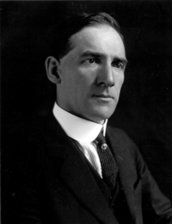Cottrell, Frederick Gardner

While a professor at the University of California, Berkeley, Frederick Gardner Cottrell (1877–1948) entered the pollution cleanup business because DuPont wanted to eliminate a problem in a process designed to manufacture sulfuric acid. DuPont hired Cottrell in 1906 as a consultant to its facility at Pinole, 20 miles north of Berkeley. The contact process used to create the acid was producing arsenic that poisoned the catalyst, so Cottrell determined that centrifuging the arsenic-contaminated sulfuric acid mists would remove the arsenic. Then came the problem of precipitating the purified mist—the innovation that became known as "Cottrellizing." He experimented with passing an electric charge to the mist globules, which then migrated to the oppositely charged electrode, where they could be collected.
In 1907 Cottrell applied electrostatics to a different process: a successful court suit filed by Solano County, California, against the Selby Smelting and Lead Company required the smelter to clean up its sulfurous smoke. The lead particles were filtered out by a "baghouse" fitted with 2,000 woolen bags, each 30 feet long, through which the dust-laden gases were blown. Cottrell designed a precipitator to recover the sulfuric acid—again from a mist—used in dissolving gold from the gold-and-silver alloy found in the lead. Cottrell later installed similar equipment at a copper smelter and a cement factory and developed a related electrostatic process for de-emulsifying oil. The fame of these operations spread, and a presentation by Cottrell at the 1910 American Chemical Society meeting in San Francisco drove home to the world that a major process for cleaning up the air was on the market.
Cottrell, born in California, graduated from Berkeley in 1896 and did one year of graduate work there; next he taught high school in Oakland for three years, then journeyed to Europe to study first with Jacobus Henricus van't Hoff in Berlin and later with Wilhelm Ostwald in Leipzig, where he received his doctorate. He was on the faculty at Berkeley from 1903 to 1911, where he conducted his earliest ventures into electrostatic precipitation. In 1911 he resigned from the university to join the U.S. Bureau of Mines, of which he eventually became director in 1919. There he worked in the World War I programs to develop processes to fix nitrogen for explosives (since the United States did not have any plants that used the Haber-Bosch process at the time) and to distill helium from air for lighter-than-air craft. From 1922 to 1930 he served as the director of the Fixed Nitrogen Research Laboratory in the Department of Agriculture, which succeeded in developing a good catalyst for a Haber-type process. As director he was also responsible for recommending what to do with the nitrogen plant erected by the government at Muscle Shoals on the Tennessee River during World War I, which was converted from explosives to fertilizer manufacturing after the war. Cottrell's recommendation that the government continue to operate it as an experimental facility was ultimately incorporated in the plans for the Tennessee Valley Authority.
Next to the electrostatic removal of particles from smokestack gases, Cottrell is probably best remembered for his creation of the Research Corporation in 1912. This foundation was set up to receive income from his patents and the patents of other public-spirited inventors and to distribute these funds to university researchers in the physical sciences as seed money—which bore fruit in many instances. Before World War II, when federal support for scientific research was slight, the Research Corporation provided much-needed funds for Ernest Lawrence's development of the cyclotron, R. H. Goddard's experiments with rockets, the processes for volume production of vitamins A and B1, and some of Robert Burns Woodward's early organic syntheses of such complex organic molecules as the drug reserpine. The foundation continues to underwrite scientific research that might not otherwise gain support—especially projects undertaken by faculty members at small colleges.
Further Reading
- American Chemical Society
- Chemical Heritage Foundation
- Electrostatic Precipitators for Power Plants, Arizona State University, Fulton School of Engineering
- Inventor Profile: Frederick G. Cottrell, National Inventors Hall of Fame
- Society of Chemical Industry
- The Chemists' Club